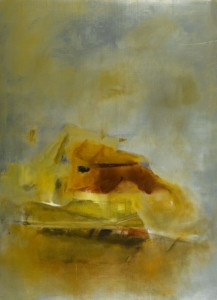
“Casa com vista” (“House with a view”) – 100 x 73 cm, oil on canvas / 2009
Catarina Pinto Leite tells me that, for these paintings, she had in mind the tragedy that recently hit the Italian city of Aquila. In her artistic revisiting of those places of catastrophe, there are formal experiences in which the quick gesture searches for structures connected to the urban landscape that end up disintegrating.
We are thus faced with the emergence of a kind of writing made up of large “characters” or, if you will, an alignment of strong blocks torn in space, or tearing the space, where everything is intertwined, as if all that was left were wobbling door frames, remains of something that lost its balance and made us lose our balance, remainders, allusions to what once existed and to what everything ended up reduced to.
What is left after everything is shaken, its melancholic remains, its surfaces spreading between black and yellow, the colors of a land struck by the sun, by catastrophe, by the tragic sense of life. What remains is this path of agonies recovered against oblivion, this obsessively poetic wandering in its deep melancholy of walking through the rubble and the ashes that emerge like in a parade over unstable horizons, to which some of the metallic backgrounds in silver give an additional humid tone of threat. We make our way through land and water landscapes seen from a certain distance, we approach houses, walls and other constructions, wandering amidst them and the darkened lunar shadows that they reflect back to us in these settings of a tragic opera dissolving into the seas and the rubbles of memory.
These are images of an inhospitable land that the eyes enter, forced to accept that nothing which is human is foreign to us, that dreams can easily run into fragments of nightmares, giving us a second nature, and that time consumes all beings and all things. But here, time is joined by catastrophe and a feeling of solitude that makes us confront fate and many of its cruel unforeseen events.
Vasco Graça Moura.
Outubro 2009.